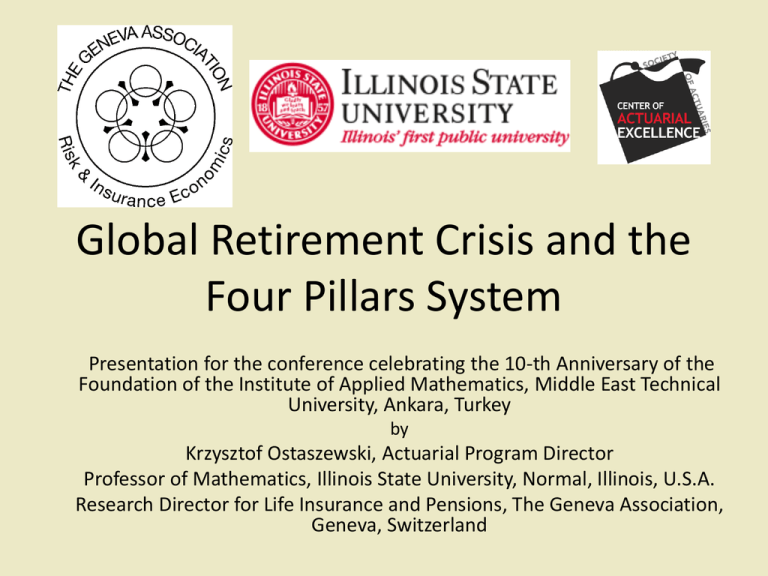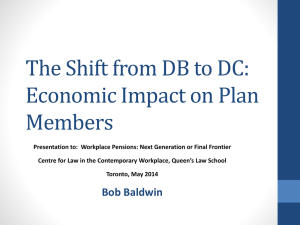Modigliani, Miller and Microinsurance
advertisement

Global Retirement Crisis and the Four Pillars System Presentation for the conference celebrating the 10-th Anniversary of the Foundation of the Institute of Applied Mathematics, Middle East Technical University, Ankara, Turkey by Krzysztof Ostaszewski, Actuarial Program Director Professor of Mathematics, Illinois State University, Normal, Illinois, U.S.A. Research Director for Life Insurance and Pensions, The Geneva Association, Geneva, Switzerland The Four Pillars • Social security or social assistance, i.e., universal public system of pensions or pension-like benefits, created as a social insurance system, or a welfare benefits system delivering results similar to social insurance. • Occupational pensions, where pension benefits for individuals are delivered by employers, with possible support of private insurance companies. • Savings, where individuals save and invest for their own retirement, using financial intermediaries, including private insurance companies, which can provide increased security of their benefits and mitigate longevity risk. • Continued employment, with barriers to partial employment that have existed worldwide, either from governments or from employers, reduced or even removed. Pillar 1: Social Insurance and social assistance for the elderly • Social insurance: – Benefits set by law (statutory benefits). – Premiums (taxes) set by law (statutory premiums) – Typically run on pay-as-you-go basis. • U.S. Social Security system accumulated a Trust Fund of approximately $2.5 Trillion, invested in special issue Treasury Bonds. • Common complaint: Social insurance is “not funded.” The difference is not in “funding” but in pricing of capital assets • Hypothetical system of retirement savings – All taxes invested in special issue government bonds, earn interest at a rate prescribed by law. – Upon retirement, withdrawals from account taxed or subsidized to equal to the amount prescribed by law. • Money saved for retirement is always placed in some capital assets, and those capital assets are then sold to fund retirement. Pillar 2: Employment-Based Pensions • U.S. design for private sector plans, prescribed by Employee Retirement Income Security Act of 1974 – Form a separate trust fund that will pay pension benefits. – Employer must provide regular funding as prescribed by plan actuary, with reports filed with the Department of Labor. – Plan liabilities calculated by plan actuary. – Since 2006 Pension Protection Act, must establish clear path to funding, and must use market-related three-segment yield curve for calculation of actuarial present value of benefits. – Trust fund assets invested in a diversified portfolio, typically about 60% stocks and 40% bonds. • Pension plans provided by states and municipal government do not have such strict funding requirements, use Government Accounting Standards. Also use actuarial valuation. Actuarial valuation of pension plans • Accrued benefit funding methods. These methods focus on maintaining a certain level of funding. They are security driven, in that they attempt to establish and maintain a sound relationship between the fund assets and the accruing liabilities. The funding requirement is then the contributions required to achieve the funding objective. The two most important methods within this category are Current Unit Credit and Projected Unit Credit. Actuarial valuation of pension plans • Prospective benefit funding methods. These methods define a certain level of contributions. They are contribution driven, and the primary objective is stability of such contributions. These contributions then define the targeted level of the fund at any point in time. The three most important methods within this category are Entry Age, Attained Age and Aggregate. The funding method does not affect the true overall cost, unless it changes people’s behavior • Cost to plan sponsor = Total benefits paid to plan beneficiaries - Member contributions to the plan - Investment income earned by the pension fund + Expenses incurred in the operation of the plan and the fund. Modigliani-Miller: Financing alone will not create value • It will only create value if: – Tax benefits or lower regulatory costs are realized, or – Bankruptcy costs are lowered, or – Agency costs are reduced, in particular if new economic projects of positive value are funded, and the value is not lost through information asymmetry, moral hazard, or other agency costs. Projected Unit Credit Method has become dominant Premium (Normal Cost) = Payment for value of benefit accrued for this year’s service, with value projected to retirement including salary increases. Example: Employee earning $60,000 gets 2% of final salary benefit for this year’s service, with 3% annual salary increases, 15 years from retirement, will have final 14 salary 60000 ×1.03 . Normal Cost is then calculated as 14 (12) 0.02 ×60000 ×1.03 × 15 E50 ×a65 . Note that discount rate(s) and mortality may be prescribed by law or chosen by the actuary. Accrued liability (AL) is calculated based on accrued benefits. Unfunded actuarial liability (UAL) = AL – Actuarial Value of Assets (F). May result in supplemental funding, subject to review through: Expected UALt+1 = (UALt + NCt)(1+i) – Contribution with interest – Benefit payments releasing the liability. Comparison with life insurance • Accrued liability <-> Reserve • Normal Cost <-> Premium • Recall standard recursive reserve formula ( kV + P )(1+ i ) = qx+k ×bk+1 + px+k × k+1V. • Reserve, a.k.a., technical provisions. • Unlike life insurance, assumptions and valuation may be adjusted. • Unlike life insurance, positive amount of surplus is not required. Solvency II and Pensions • EU’s Solvency II will impose capital requirements on insurance firms. • Solvency Capital Requirement (SCR): capital required to ensure that the insurance firm is able to meet its obligations over the next 12 months with a probability of at least 99.5%. • Minimum Capital Requirement (MCR): Threshold for regulatory intervention. Intended as 85% percentile, bounded between 25% and 45% of SCR. Capital rules for insurance and pensions • Historically – Life insurance firms used relatively low valuation rate, and were required to hold capital. Capital paid with excess of earned rate over valuation rate, plus its own earned rate. – Pensions plans used relatively high valuation rate (60% stocks and 40% bonds portfolio), and were allowed to have negative surplus, amortized with part of normal cost and all of supplementary cost. • Solvency II proposal: Treat plan sponsor commitment to contribute as a “shadow capital” Defined Contributions Plans taking over Key issue for defined contribution plans • Under constant force of mortality and constant force of interest, an amount A purchases an annual lifetime benefit of A ( m + d ) . • In 1987, you could take the force of interest to be 9%, and force of mortality at age 65 maybe 3%, million dollars bought as much as $120,000 p.a. • In 2011, you could take force of interest to be 1.5%, force of mortality at age 65 maybe 2.5%, million dollars buys $40,000 per annum. Actually, in the U.S. market rate is about $30,000. Pillar 3: Private savings including life annuities • This is the only area of retirement systems where market valuation of the cost of retirement is the rule. • Perceived as expensive and inaccessible to many. • Standard problem with insurance – The contribution to the society from the insurance industry is to make more risky activities possible. – But for this process to work, insurance must be priced properly to control moral hazard. – If customers are not complaining about insurance being too expensive, the actuary is not doing his/her job. – If insurance is too cheap, calamities result. What is the risk addressed in providing pensions? • Are life annuities insurance? • It is common to say that life annuity is an insurance policy against living too long. • Allow me to propose another perspective: Life annuity is insurance against the risk of having to withdraw from labor force. • Withdrawal from labor force is a risky decision: One may gain or lose human capital when unemployed. Role of financial intermediaries • What is the role of financial intermediaries in the economy? • Banking often perceived as spread business. It is, in fact, derivative securities business. • Life insurance is the business of creating derivative securities (life insurance and annuity) on human capital. Pillar 4: Continued Employment • Most developed economies in the 1950s created incentives for workers to leave the labor force between ages 55 and 65. • But now, normal retirement age is being increased in most countries. • Forced retirement amounts to confiscation of human capital. • Taxation of pension benefits or reduction of them for working retirees is a partial confiscation. Interest rates in the last 25 years, UK, France, USA, Germany, Japan, and Switzerland, sources: Oliver Wyman and Oxford Economics Real GDP growth in the same countries, sources: Oliver Wyman and Oxford Economics 220 Growth in social spending, EU 15, (source: OECD) Real public social spending 210 Real GDP 200 190 180 170 160 150 140 130 120 110 100 1990 1995 2000 2005 07 United States (source: OECD) 220 Real public social spending 210 Real GDP 200 190 180 170 160 150 140 130 120 110 100 1990 1995 2000 2005 07 Japan (source: OECD) 220 Real public social spending 210 Real GDP 200 190 180 170 160 150 140 130 120 110 100 1990 1995 2000 2005 07 Public spending since the 2008 crisis, USA (source: OECD) 150 30 28 140 26 24 130 22 20 120 18 16 110 14 12 100 10 90 8 2007 2008 2009 2010 2011 2012 United Kingdom (source: OECD) 150 30 28 140 26 24 130 22 20 120 18 16 110 14 12 100 10 90 8 2007 2008 2009 2010 2011 2012 Longevity (source: World Bank) The effect of the 2008 Credit Crisis • Pillar 1: Public finance systems in trouble. Extensive financial suppression imposes additional cost on the real economy. And weak economy reduces tax collections. • Pillar 2: Employers move away from providing pension guarantees, derisking is the word of the day. • Pillar 3: Low rates of return and very high cost of retirement benefits. • Pillar 4: Reduced employment opportunities. The Four Pillars should work in concert • Pillar 1: By providing minimum standard of living guarantees it can enhance incentives to work, and reduce incentives to lobby. • Pillar 2: Can enhance accumulation of human capital. • Pillar 3: Provides market signals for the entire retirement system. • Pillar 4: Efficient societal use of human capital. No savior in finance • The last 25 years have been market by nearly revolutionary financial innovation. • Some of it has unraveled in the 2008 Credit Crisis. • But finance alone does not create value, value is created in the real economy. • The Four Pillars should serve the real economy: taxes, bankruptcy and agency costs. Does this matter for Turkey? Ratio of working-age population between 15 and 64 to the rest of population (source: Japan’s Central Bank) What is the optimal way to pay off a liability? • Consider a liability that requires a stream of payments such that the present value at time t 0 of payment at time t is Lt. Define ALt = å Li . i=1 Also let AL0 = 0. • Problem: Derive an optimal series of payments, with Pt being the present value at time 0 of payment to be made at time t – 1 (insurance premium is paid at the beginning of the year). Optimal with respect to what? • Constraint 1: Present values of premiums form an non-increasing sequence: other Pt ³InPt+1 . words: Funding should not be allowed to be just postponed (or: No Lucy Ricardo Method of Funding). • Constraint 2: APt = P1 + ...+ Pt ³ ALt . In other words: No negative reserve. • Minimize: APt – ALt for every t. Solution • Consider F(t) = ALt and extend it to be piecewise linear and continuous, with the smallest number of points of nondifferentiability possible. • Let F*(t) be the smallest concave majorant of F(t). Then the derivative of F*(t) provides the optimal funding for this liability. Limitations • This result is deterministic. • It does not need to assume one interest rate, we can use a yield curve for present value calculation. • For large pension groups cash flows become close to being deterministic. • Purely financial result, while funding involves a choice of securities in the portfolio, creating agency problems. Demographics • The retirement challenges of developed economies have been mostly presented as a demographic issue. • But it is not demographic issue, it is entirely an issue of pricing of capital assets. • When the first public universal pension system was introduced in Germany, life expectancy was in the range of 46. Now it is around 80 in most developed economies. Retirement is more expensive, but paid mostly the same way as before. • It has become dramatically more expensive following the 2008 Credit Crisis. Why do people not know the cost of retirement? • Imagine if shoes were provided by stateowned stores, at prescribed times, with every citizen paying for them through a payroll deduction. • Would citizens know the price of shoes under those circumstances? • Would you blame them if they did not? • What if the state-owned store coexisted with small bazaar-like markets for shoes? Advice of the Polish Plumber • Central actor in the debate in France over the European Union constitution, which was roundly rejected by French voters in 2005. • Solutions proposed for the retirement systems problems following the Credit Crisis of 2008 all concentrate on finance: – Quantitative Easing – Stimulus – Temporary tax incentives Cut the pipe three times and it is still too short? Copernicus Retirement Model • Copernicus died on May 24, 1543 in Frombork, Poland. • On that day, we was presented an advance copy of De Revolutionibus Orbium Coelestium, his main work. • He was in very bad health, but could review the book and make some corrections. • On the day of his departure he was still working on that piece of work that defines him as one of the great contributors to the mankind’s body of knowledge.





